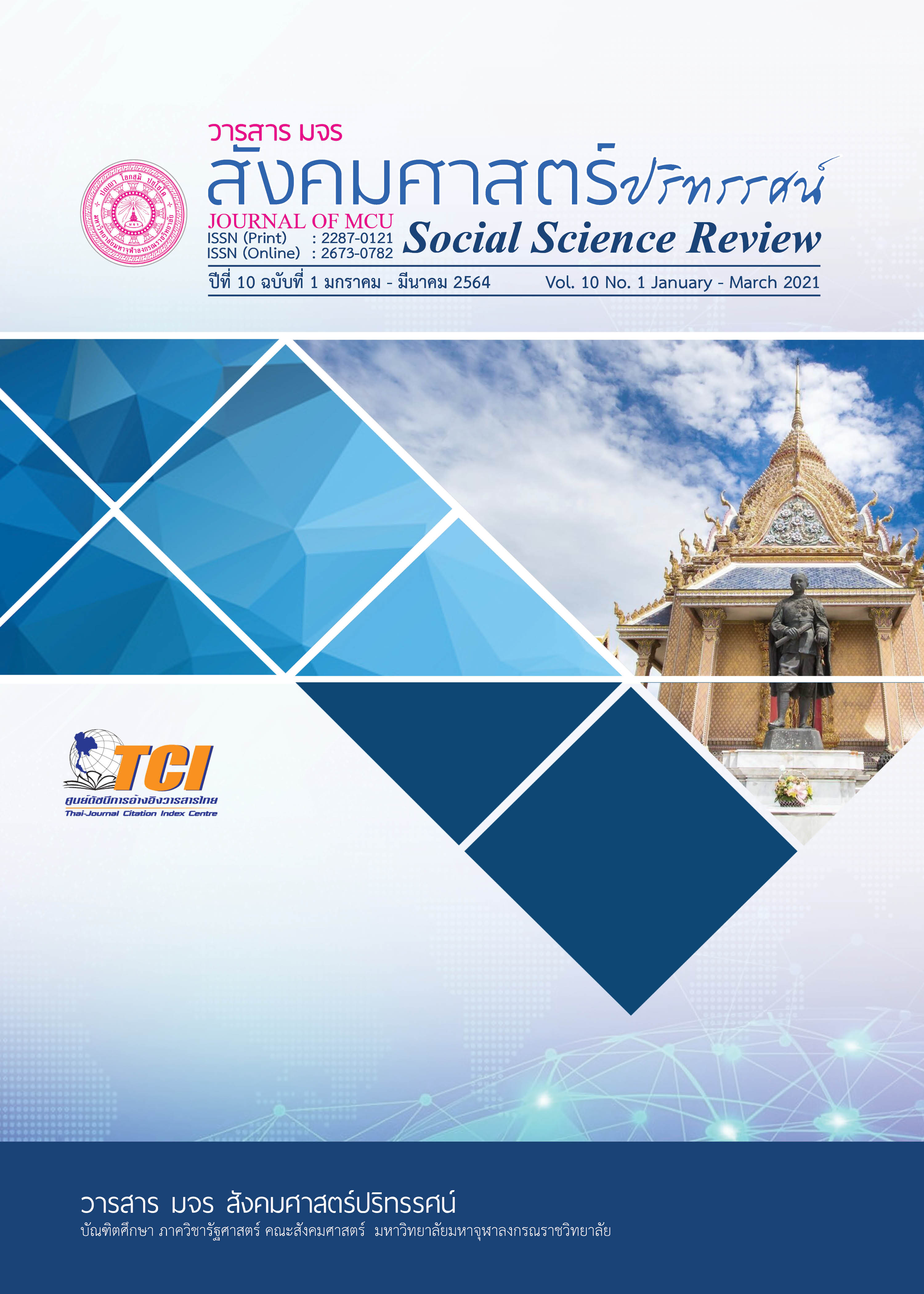รูปแบบการจัดการศึกษาธรรมศึกษาตามระบบ E-Learning ของคณะสงฆ์จังหวัดพระนครศรีอยุธยา
คำสำคัญ:
การจัดการศึกษา, ธรรมศึกษา, ระบบ E-Learningบทคัดย่อ
บทความวิจัยนี้มีเพื่อศึกษาสภาพทั่วไป กระบวนการ และนำเสนอรูปแบบ เป็นการวิจัยแบบผสานวิธี ระหว่างการวิจัยเชิงคุณภาพเก็บข้อมูลด้วยการสัมภาษณ์เชิงลึกกับผู้ให้ข้อมูลสำคัญจำนวน 19 รูปหรือคน และการสนทนากลุ่มเฉพาะกับผู้ทรงคุณวุฒิ จำนวน 12 รูปหรือคน วิเคราะห์ข้อมูลเชิงพรรณนาเรียบเรียงและจำแนกอย่างเป็นระบบ และการวิจัยเชิงปริมาณ เป็นการวิจัยเชิงสำรวจจากแบบสอบถามกับพระสังฆาธิการ ครูสอนพระปริยัติธรรม ผู้บริหารสถานศึกษา ครู และนักเรียน จำนวน 396 คน สถิติที่ใช้ในการวิจัย คือ ค่าความถี่ ค่าร้อยละ ค่าเฉลี่ย ค่าเบี่ยงเบนมาตรฐาน ผลการวิจัยพบว่า 1. คณะสงฆ์ มีการดำเนินการร่วมกับสถานศึกษาอย่างต่อเนื่อง มีการจัดตั้งศูนย์ด้านข้อมูลให้กับพระสอนศีลธรรม และแม่กองธรรมสนามหลวงได้มีการจัดทำเว็บไซต์ และช่องการสื่อสารอื่นๆ 2. ดำเนินการแต่งตั้งคณะกรรมการ ระดมความคิดเห็นผู้ที่เกี่ยวข้อง จัดทำแผนปฏิบัติการ ปรับปรุงรูปแบบการเรียนการสอน บูรณาการการจัดการเรียนการสอนด้วยระบบ E-Learning จัดอบรมให้ความรู้ในการใช้ระบบ 3. รูปแบบการจัดการศึกษา ประกอบด้วย 3.1 การออกแบบหลักสูตรร่วมกับสถานศึกษา 3.2 ทำไดอะแกรมการเรียนรู้ 3.3 ทำแบบทดสอบก่อนเรียนและหลังเรียน 3.4 จัดทำคู่มือการใช้งานแบบทดสอบออนไลน์ 3.5 จัดทำคู่มือการใช้งานและเผยแพร่ พัฒนาระบบ E-Learning ผ่านมือถือ 3.6 พัฒนาระบบการเรียนรู้แบบสะสมแต้ม 3.7 เพิ่มช่องทางการติดต่อสื่อสาร 3.8 พัฒนาสื่อการเรียนการสอน 3.9 สร้าง 1 อำเภอ 1 ศูนย์การเรียนรู้ระบบ E-Learning
เอกสารอ้างอิง
เจษฎา เมฆะสุวรรณโรจน์. (2549). การพัฒนาระบบอีเลิร์นนิงแบบผสมผสาน กรณีศึกษา: โรงเรียนพระปฐมวิทยาลัย (รายงานการวิจัย). นครปฐม : คณะวิทยาศาสตร์ มหาวิทยาลัยศิลปากร.
ทีมข่าวศาสนา ไทยรัฐออนไลน์. (2562). อีเลิร์นนิงธรรมศึกษา: มิติใหม่วงการคณะสงฆ์ พัฒนาหลักสูตรการเรียนการสอนพระพุทธศาสนา. สืบค้น 5 กันยายน 2562, จากhttps://www.thairath.co.th/news/local/1143670
ธนเดช ศักดิ์สุวรรณ และคณะ. (2559). การพัฒนาบทเรียน E-Learning กลุ่มสาระการเรียนรู้การงานอาชีพและเทคโนโลยี เรื่อง คอมพิวเตอร์ในชีวิตประจำวัน ชั้นมัธยมศึกษาปีที่ 1 (รายงานการวิจัย). พิษณุโลก : คณะครุศาสตร์ มหาวิทยาลัยราชภัฏพิบูลสงคราม.
วีรพจน์ ลือประสิทธิ์สกุล. (2540).TQM Living Handbook: an Executive Summary. พิมพ์ครั้งที่ 2. กรุงเทพฯ : บีพีอาร์แอนด์ทีคิวเอ็ม คอนซัลแทนท์.
ศยามน อินสะอาด. (2561). การออกแบบบทเรียน E-Learning เพื่อพัฒนาทักษะการคิดขั้นสูง. กรุงเทพฯ : ซีเอ็ดยูเคชั่น.
สำนักพัฒนาคุณธรรมจริยธรรม กรมการศาสนา กระทรวงวัฒนธรรม. (2549). การศึกษารูปแบบและแนวทางการพัฒนาการเรียนการสอนธรรมศึกษาในสังคมไทย: ศึกษาสภาพความเป็นจริงและความคาดหวังของผู้เรียนธรรมศึกษาทุกระดับช่วงชั้น. กรุงเทพฯ: โรงพิมพ์ชุมนุมสหกรณ์การเกษตรแห่งประเทศไทยจำกัด
อนุชา สะเล็ม. (2560). การประยุกต์ใช้ E-Learning ในกระบวนการเรียนการสอน วิทยาลัยเทคโนโลยีบริหารธุรกิจมีนบุรี กรุงเทพ (รายงานการวิจัย). กรุงเทพฯ : คณะวิทยาการและเทคโนโลยีสารสนเทศมหาวิทยาลัยเทคโนโลยีมหานคร.
ดาวน์โหลด
เผยแพร่แล้ว
รูปแบบการอ้างอิง
ฉบับ
ประเภทบทความ
สัญญาอนุญาต
ลิขสิทธิ์ (c) 2021 วารสาร มจร สังคมศาสตร์ปริทรรศน์

อนุญาตภายใต้เงื่อนไข Creative Commons Attribution-NonCommercial-NoDerivatives 4.0 International License.
เพื่อให้เป็นไปตามกฎหมายลิขสิทธิ์ ผู้นิพนธ์ทุกท่านต้องลงลายมือชื่อในแบบฟอร์มใบมอบลิขสิทธิ์บทความให้แก่วารสารฯ พร้อมกับบทความต้นฉบับที่ได้แก้ไขครั้งสุดท้าย นอกจากนี้ ผู้นิพนธ์ทุกท่านต้องยืนยันว่าบทความต้นฉบับที่ส่งมาตีพิมพ์นั้น ได้ส่งมาตีพิมพ์เฉพาะในวารสาร มจร สังคมศาสตร์ปริทรรศน์ เพียงแห่งเดียวเท่านั้น หากมีการใช้ภาพหรือตารางหรือเนื้อหาอื่นๆ ของผู้นิพนธ์อื่นที่ปรากฏในสิ่งตีพิมพ์อื่นมาแล้ว ผู้นิพนธ์ต้องขออนุญาตเจ้าของลิขสิทธิ์ก่อน พร้อมทั้งแสดงหนังสือที่ได้รับการยินยอมต่อบรรณาธิการ ก่อนที่บทความจะได้รับการตีพิมพ์ หากไม่เป็นไปตามข้อกำหนดเบื้องต้น ทางวารสารจะถอดบทความของท่านออกโดยไม่มีข้อยกเว้นใดๆ ทั้งสิ้น





